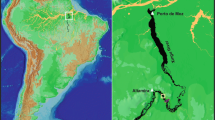Abstract
Vagile large juvenile and adult fishes are often under-represented in traditional sampling of Sargassum–associated fishes in the open ocean. We used underwater video recordings from free-floating camcorders and a remotely operated vehicle (ROV) to assess the relative abundance of large mobile fishes under large Sargassum mats (> 10 m diameter), under dispersed clumps of Sargassum (< 1 m diameter), and in open water without Sargassum as a reference. In addition, we conducted dipnet sampling in each Sargassum treatment for a comparison to traditional methods. All samples were obtained in September 1992 along the western wall of the Gulf Stream off Cape Hatteras, North Carolina. A total of 31 fish taxa were identified from both video and dipnet collections. Only 8 taxa were identified in both video and dipnet collections, while 11 taxa were seen only in video and 10 were only found in dipnet collections. Dipnet collections were dominated by juvenile balistids and other small, cryptic fishes, while the video observations were mainly of larger, rapidly-moving carangids. Fish diversity increased with the amount of continuous Sargassum habitat: four taxa were observed when no Sargassum was present, 12 under clumps, and 19 under mats. Our results indicated that mat morphology significantly affects the Sargassum–associated fishes, and that both video and traditional capture methods are complementary and should be used together to accurately census this community.
Similar content being viewed by others
References cited
Bortone, S.A., P.A. Hastings & S.B. Collard. 1977. The pelagic Sargassum ichthyofauna of the eastern Gulf of Mexico. N.E. - Gulf. Sci. 1: 60–67.
Butler, J.N., B.F. Morris, J. Cadwaller & A.W. Stoner. 1983. Studies of Sargassum and the Sargassum community. Bermuda Biol. Sta. Spec. Publ. 22: 1–85.
Cillaurren, E. 1994. Daily fluctuations in the presence of Thunnus albacares and Katsuwonus pelamis around fish aggregating devices anchored in Vanuatu, Oceania. Bull. Mar. Sci. 55: 581–591.
Dooley, J.K. 1972. Fishes associated with the pelagic sargassum complex, with a discussion of the sargassum community. Cont. Mar. Sci. 16: 1–33.
Fedoryako, B.I. 1980. The ichthyofauna of the surface waters of the Sargasso Sea south-west of Bermuda. J. Ichthyol. 20: 1–9.
Fedoryako, B.I. 1989. A comparative characteristic of oceanic fish assemblages associated with floating debris. J. Ichthyol. 29: 128–137.
Fine, M.L. 1970. Faunal variation on pelagic Sargassum. Mar. Biol. 7: 112–122.
Friedlander, A., J. Beets & W. Tobias. 1994. Effects of fish aggregating device design and location on fishing success in the U.S. Virgin Islands. Bull. Mar. Sci. 55: 592–601.
Gibbs, R.H. & B.B. Collette. 1959. On the identification, distribution and biology of the dolphins, Coryphaena hippurus and C. equisetis. Bull. Mar. Sci. Gulf Carib. 9: 117–152.
Higashi, G.R. 1994. Ten years of fish aggregating device (FAD) design development in Hawaii. Bull. Mar. Sci. 55: 651–666.
Hunter, J.R. & C.T. Mitchell. 1966. Association of fishes with flotsam in the offshore waters of Central America. U.S. Fish. Bull. 66: 13–29.
Hunter, J.R. & C.T. Mitchell. 1968. Field experiments on the attraction of pelagic fish to floating objects. J. Cons. int. Explor. Mer. 31: 427–434.
Jones, R.S. & M.J. Thompson. 1978. Comparison of Florida reef fish assemblages using a rapid visual technique. Bull. Mar. Sci. 28: 159–172.
Kimmel, J.J. 1985. A new species-time method for visual assessment of fishes and its comparison with established methods. Env. Biol. Fish. 12: 23–32.
Kingsford, M.J. & J.H. Choat. 1985. The fauna associated with drift algae captured with a plankton-mesh purse seine net. Limnol. Oceanog. 30: 618–630.
Kingsford, M.J. & J.H. Choat. 1986. Influence of surface slicks on the distribution and onshore movements of small fish. Mar. Biol. 91: 161–171.
Kingsford, M.J. 1992. Drift algae and small fish in coastal waters of northeastern New Zealand. Mar. Ecol. Prog. Ser. 80: 41–55.
Kingsford, M.J. 1993. Biotic and abiotic structure in the pelagic environment: importance to small fishes. Bull. Mar. Sci. 53: 393–415.
Manooch, C.S., III & W.T. Hogarth. 1983. Stomach contents and giant trematodes from wahoo, Acanthocybium solanderi, collected along the south Atlantic and Gulf coasts of the United States. Bul. Mar. Sci. 33: 227–238.
Manooch, C.S., III & D.L. Mason. 1983. Comparative food of yellowfin tuna, Thunnus albacares and blackfin tuna, Thunnus atlanticus, from the southeastern and Gulf of Mexico coasts of the United States. Bull. Japan. Soc. Sci. Fish. 50: 1511–1525.
Manooch, C.S., III, D.L. Mason & R.S. Nelson. 1985. Foods of little tunny, Euthynnus alletteratus collected along the southeastern and Gulf coasts of the United States. Bull. Japan. Soc. Sci. Fish. 15: 1207–1218.
Michalopoulos, C., P.J. Auster & R.J. Malatesta. 1992. A comparison of transect and species-time counts for assessing faunal abundance from video surveys. Mar. Tech. Soc. J. 26: 27–31.
Morgan, S.G., C.S. Manooch III, D.L. Mason & J.W. Goy. 1985. Pelagic fish predation on Cerataspis, a rare larval genus of oceanic penaeoids. Bull. Mar. Sci. 36: 249–259.
Rountree, R.A. 1990. Community structure of fishes attracted to shallow water fish aggregation devices off South Carolina, U.S.A. Env. Biol. Fish. 29: 241–262.
Settle, L.R. 1993. Spatial and temporal variability in the distribution and abundance of larval and juvenile fishes associated with pelagic Sargassum. Masters Thesis, University of North Carolina-Wilmington, Wilmington 64 pp.
Zar, J.H. 1984. Biostatistical analysis. Prentice-Hall, Englewood Cliffs. 718 pp.
Author information
Authors and Affiliations
Rights and permissions
About this article
Cite this article
Moser, M.L., Auster, P.J. & Bichy, J.B. Effects of mat morphology on large Sargassum-associated fishes: observations from a remotely operated vehicle (ROV) and free-floating video camcorders. Environmental Biology of Fishes 51, 391–398 (1998). https://doi.org/10.1023/A:1007493412854
Issue Date:
DOI: https://doi.org/10.1023/A:1007493412854




